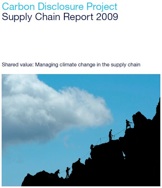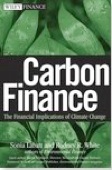



The finance behind climate change reductions
The countdown is on for the upcoming Climate Change Copenhagen meeting, where Kyoto II will be negotiated at the end of 2009. And according to environmentalists and scientists alike, this new round of negotiations stands as a “Make it or Break it” crucial turning-point for the planet, in order to stop climate change. Meanwhile, the financial sector is already busy striving to operationalize the cost of carbon emissions and figure out how to manage the climate change risks for individual corporations.
The original Kyoto Protocol (Kyoto I) covered the 2008-2012 period, for cuts of global greenhouse gas (GHG) emissions of 5.2% on average below the 1990 level, in mainly so-called rich countries.
Four to severn times Kyoto cuts
The UN Climate Summit in Copenhagen will mean four to seven times the scale of Kyoto I over a similar period. Indeed, the next round of GHG emissions reductions will aim for 25 to 40% below 1990 levels, from 2013 to 2018 or 2020 (all to be finalized, Dec 7-18, 2009 in the Danish capital). The European Union has already committed to a 20% reduction by 2020.
“According to scientists, global GHG emissions need to peak by 2015 (i.e. reach their maximum and start decreasing),” says Clare Demerse of the Pembina Institute, “for the world to have a fair share of staying below a 2 degrees Celsius temperature rise, above pre-industrial levels (i.e. 1850s). Copenhagen will set the rules for this really critical period where we need to reach that peak,” adds the senior policy analyst in climate change issues for the Ottawa-based environmental group.
Two tracks for developed and emerging countries
The second major change in Kyoto II will be that both developed and emerging countries will have to walk the talk, though on two different tracks. “There will be the Kyoto track, with specific targets for the rich countries. And there will be the Convention track for developing countries,” including China, India and Brazil.
This second track will not have specific targets, but rather incentives, including a Fund financed by rich countries to assist developing countries, “similar to the Montreal Protocol to cut ozone emissions,” says Pembina's Institute Claire Demerse.

Last chance in Copenhagen
Next December will be the drop dead cut off to give all signatory countries the time to ratify the new agreement at the national level, before Jan. 1st 2013 [when the current Kyoto Protocol expires], reminds Demerse. For instance, it took close to four years for Kyoto I to be ratified by enough countries to actually come into effect in 2005, while all the rules had been finalized in 2002 - though the Protocol was actually signed in 1997 in the Japanese City of Kyoto.
Three more meetings in 2009 will pave the way to the final Copenhagen high profile meeting for the world to decide “how to bare the brunt”, says Demerse.
The private sector is not waiting for national governments, the United Nations and environmental groups to design an international policy framework at the upcoming Copenhagen meeting. The finance industry, for instance, is already working on new ways of measuring and managing wealth in a low-carbon diet world.
New Carbon Finance Tools
For instance, Innovest Strategic Value Advisors, an international rating agency in the environmental, social and governance areas, has designed a corporate carbon risk and performance analysis tool.
The Carbon Beta rating not only measures how companies are managing their carbon emissions and their exposure to carbon risks, but also how a corporation is considering carbon related opportunities. This measure is also evalutating if the organization is proactive or simply too conservative in terms of looking at potential changes. Each company is rated from AAA to CCC and in turn investment portfolios can be evaluated accordingly.
“We are measuring the competitive advantage of companies that have adapted to a low-carbon world and the erosion of the asset values of the organizations that didn’t,” sums up Pierre Trevet, Managing Director for Innovest in San Francisco.
One key variable, on a global level, is the immense variability of the regulatory context from one country to the next, says Pierre Trevet, underlining how crucial it will be to have emerging countries and the United States as part of Kyoto II.
“This will be the nexus of the negotiations in Copenhagen. It will create a more level playing field in terms of the geopolitics of carbon, the regulatory constraints and costs scenarios. It could also enhance the market for renewable energies and change how companies are managed.”
Carbon Disclosure Project: $ 57 Trillion
Major institutional investors are already considering measuring carbon risk exposure as a fiduciary responsibility. For instance, the Carbon Disclosure Project (CDP) issues an annual climate change questionnaire to more than 3,000 corporations globally, on behalf of its members: 385 institutional investors with a total of $57 trillion of assets under management early 2009.
CDP members include banks, pension funds, insurance companies, such as Barclays, HSBC, Goldman Sachs, Merrill Lynch and Morgan Stanley. Created in 2000, the England-based charity has an open goal of “encouraging private and public sector organizations to measure, manage and reduce emissions and climate change impacts.”
Per Capita Targets
Solutions are clearly available while changes for emerging countries might be even more pronounced than in developed countries. “We have viable, affordable alternatives in front of us. For richer countries, targets are attainable. But in poorer countries, it simply means poverty reduction,” says White.
In the short-term though, both the economic recession and the new U.S. Obama government will do more than the new Copenhagen Agreement, expects White: “In the US right now, they are talking about a Cap & Trade bill through Congress within 6 to 12 months,” leading to a system in place possibly by 2011.
Cap & Trade in Canada?
For Canada, this means a policy reversal for the current Conservative government, considering now a cap and trade system, while previously the Harper Government was advocating for intensity targets. Incidentally, the Montréal Climate Exchange has actually been ready for several years to trade carbon credits, but is waiting for the Federal policy green-light.
In the end, the Copenhagen Agreement should bring further business development possibilities, predicts White. “There are a lot of interesting new opportunities, in the insurance, banking, accounting and in the legal professions. On the legal side, there are now many climate change practices, dealing with CO2 reduction credits.”
As for Canada, the carbon finance expert prognosis is unequivocal: in the upcoming Copenhagen negotiations, unlike in the previous Bali or Poznan major Climate Change UN meetings “it is very important that the Canadian government plays an active and positive role.”
This article was first published in Vantage magazine as: "The Next Kyoto: How the financial sector is preparing for a lower carbon economy"
February 2, 2009
Information
While Kyoto 2 in Copenhagen approaches, financial tools are being designed for a low carbon diet world.


The U.N. Climate Change meeting in Copenhagen (Dec. 7-18, 2009) will negotiate the "after Kyoto" greenhouse gases reductions.




